In the last four decades, the Galapagos Sea Lions and Galapagos Fur Seals have seen significant population declines due to the changing climate, pollution and invasive species. These pinnipeds have been listed on the Red List of Threatened Species of the International Union for Conservation of Nature.
©Joshua Vela
Dr. Diego Paez-Rosas is leading the research, a distinguished Galapagos Marine Scientist at the Universidad San Francisco de Quito. He is supported by USFQ researchers and the Galapagos National Park Directorate. Paez-Rosas, who has been working on marine megafauna research for the past two decades, calls Galapagos pinnipeds the “sea sentinels”. By studying their behavior, they can gain insight into the health of the ecosystem.
Experts say that climate change has a tendency to increase the frequency and intensity of El Nino events, which increases ocean temperatures. This temperature increase in the Galapagos Marine Reserve causes a decrease in productivity, and the food resources of the pinnipeds become scarcer.
They have a diverse diet, which bodes well for their ability to adapt to future changes in marine life communities brought on by climate change. Their diet is diverse, which means they will be able to adapt well to the future changes that climate change may bring about in marine life communities.
Galapagos Conservancy Director of Conservation Dr. Jorge Carrion said that the research would produce baseline data to help conserve the Galapagos Pinnipeds. It will also allow researchers to examine the long-term impacts of climate change.
Galapagos Conservancy thanks Dr. Diego Paez Rosas for his contributions to the conservation and protection of Galapagos ecosystems. His research on the relationship between Galapagos Pinnipeds and climate change will help conserve these species.
©Joshua Vela
El Niño, which is a global climate anomaly, can affect the Galapagos Archipelago. El Niño-Southern Oscillation disrupts the ecosystems of the Galapagos Archipelago with increased ocean temperatures and rainfall. This affects marine species negatively, while benefiting some terrestrial species. It also challenges the cacti-dominated terrain and increases the risks from invasive plant species. El Niño will affect virtually all aspects of island life, according to Washington Tapia, Galapagos Conservancy’s General Director.
El Nino’s effects on terrestrial life: A balance between the two
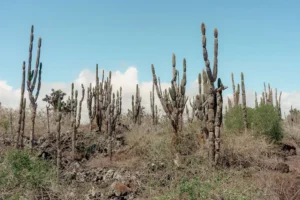
©Joshua Vela
Galapagos Giant Tortoises These iconic creatures showed mixed reactions to previous El Niño events. Adapting to the 1982-83 El Nino, they moved lower in elevation. The 1997-98 event, however, caused many nests to flood and disrupt breeding, but increased food availability. This boosted growth and survival rates.
Landbirds Due to the increased growth of plants and insect production, these terrestrial birds, some of which are unique to Galapagos tend to increase their reproduction. The increase in breeding that occurs during El Niño is countered, however, by diseases such as avian pox.
Rodents and Invertebrates. Although limited data is available, certain rodents and reptiles are dependent on predictable rainfall patterns. Invertebrates are also likely to be challenged, especially by invasive species that thrive in moister conditions. Most species, however, thrive under El Niño because of the relief from drought that increased rainfall provides.
Plant life: Flora is generally more abundant during El Niño, thanks to the sudden abundance of water in a typically dry environment. However, some species are affected.

©Joel Sangolqui
Marine Fauna: Fighting the Warmth El Nino is a warming phenomenon that can be disastrous for marine species.
Green Sea Turtles and Marine Iguanas : As primary food sources diminish due to warmer sea conditions, this animals experience significant mortality during El Niño. This is exemplified in the 90% decrease in marine iguanas in 1997-1998.
Sea Lions During El Niño, sea temperatures rise and there are fewer fish for the animals to eat. This causes a drastic decline in their population.
Marine birds: Penguins and Flightless Cormorants are often seen to skip breeding. They also experience an increase in mortality due to lack of food and spread out widely looking for food.
Human Community: El Nino’s socioeconomic effects can put human resilience to the test.
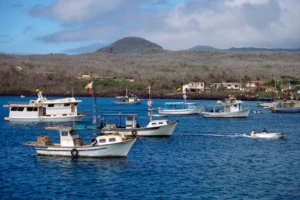
©Barrett Walker
El Niño poses significant challenges for the Galapagos Islands’ economic foundations, especially in tourism and fisheries.
Tourism could be affected by climate change due to the decline of key species. This would affect visitor numbers and experiences.
The fishing industry is vital for local communities. However, it faces threats due to changes in marine species’ abundance caused by rising temperatures and changes in upwelling patterns – the process in which cold waters rich in nutrients from deep oceans rise to the surface. Modifications in the upwelling pattern can affect fish populations and disrupt the food chain. It is vital to ensure the sustainability of fishing practices and emblematic species in the face of climate change.
The human well-being can also be affected by invasive species. Flooding can also damage infrastructure, such as roads.
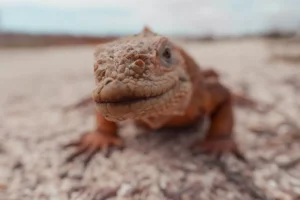
©Joshua Vela
Looking Ahead:
To ensure resilience for local communities and unique biodiversity, planning and anticipation are key. Tapia says that taking action now is an invitation to “protect our past and create a sustainable future on this iconic archipelago.”
El Niño, and the climate change it brings with it in Galapagos, are ultimately a call to global and local action. Galapagos is a unique jewel that requires collaboration, adaptation, behavior change, and conservation.
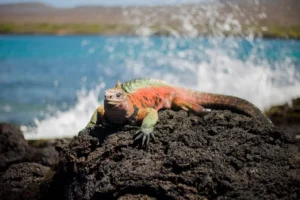
©Joshua Vela
Transforming Waste into Innovation: Oscar’s Galapagos Initiative
Oscar Guiracocha Andrade is a native from San Cristobal Island and he spearheads an innovative conservation project in the remote Galapagos. Oscar’s initiative, supported by the Galapagos Conservancy conservation grant program, transforms plastic waste to sustainable accessories and promotes environmental stewardship.
Innovative Solutions for Galapagos Wellbeing
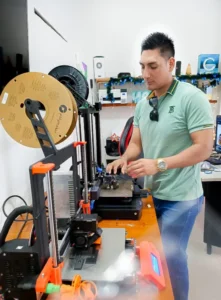
©Galápagos Conservancy
Oscar’s innovative approach to plastic pollution involves crafting customized items like cellphone holders and keyschains. One of the Galapagos Islands’ first mechanical arms was created using 3D printed technology and recycled plastics. This innovation improves the lives of residents on San Cristobal Island. It is a testament to Oscar’s commitment to the environment, which combines passion, ecological responsibility and innovation.
Oscar expresses his gratitude for the Galapagos Conservancy’s support and emphasizes that innovation is crucial to the health of Galapagos as well as its local community. Galapagos Conservancy support has catalyzed his commitment to find sustainable solutions for the natural wonderland and community’s wellbeing.
Contributions that transcend Galapagos
Several entrepreneurs have made their dreams a reality, thanks to the generosity of donors. Galapagos Conservancy played a crucial role in initiatives such as Oscar’s. This legacy of conservation and change was created by the Conservancy. These contributions have a lasting effect and foster transformations which contribute to a brighter future for the Galapagos Islands.
Donor contributions have supported more than 160 conservation projects and initiatives that were led by Galapagos locals, primarily women entrepreneurs, since 2021. These initiatives are not only important for the conservation of wildlife, but they also contribute to the well-being and prosperity of the local community. We are grateful to our readers for their support, and we invite them to help us continue our mission of creating a vibrant and sustainable Galapagos.
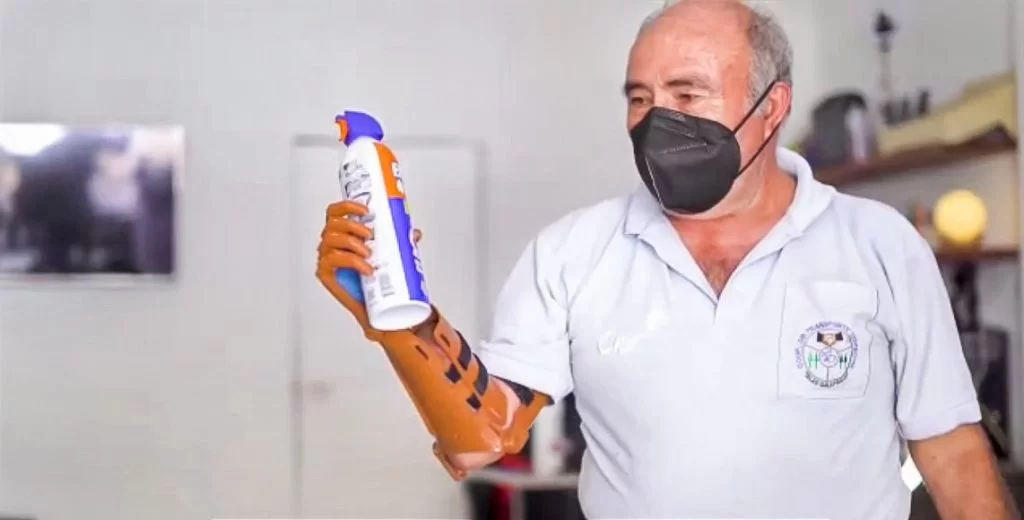
©Galápagos Conservancy
The Remarkable Return Of 136 Galapagos Tortoises To Their Natural Habitat
In partnership with Galapagos Conservancy and the Galapagos National Park Directorate 136 juvenile tortoises were successfully returned to the Cinco Cerros region on Isabela Island’s Cerro Azul Volcano. These tortoises were aged between 5 to 9 years and returned to their habitat. This is the only place in which populations of Sierra Negra volcano and Cerro Azul coexist.
The Breeding Center and the Natural State
The journey begins on Isabela Island at the Arnaldo Tupiza Breeding and Rearing Center for Chamaidan, where park rangers are dedicated to their development and well-being.
The tortoises are in the best possible condition to embark on their exciting journey home to enjoy life in its natural state. After being quarantined and dewormed as well as analyzed for their health and microchip-marked for identification, 136 turtles were transported by helicopter to the idyllic south of Isabela Island.
Aerial Support in Conservation
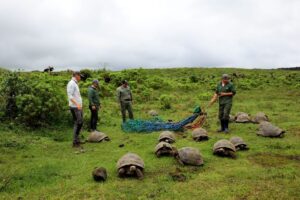
©Galápagos Conservancy
Financial support from passionate conservationists made it possible for us to transport these tortoises safely via helicopter. This is an important tool that has increased our capacity to move this species. The only other option would have been to move them by sea, and then on shoulders over several kilometers of challenging terrain and lava fields. It would be a very difficult task, which would require multiple expeditions and a lot of time. Your contributions have been crucial in helping us overcome these challenges and ensure the success of our conservation program.
Repatriation of turtles to Isabela Island is crucial in restoring ecological balance. Tortoises, which are herbivores in their natural habitat, actively contribute to the shaping of the landscape and the dispersal of seeds. These factors are vital in maintaining ecosystem stability. Dr. Jorge Carrion is our Director of Conservation and he stressed that we must remain vigilant as this species faces a threat from invasive species. We will therefore continue to monitor the situation closely.
The Future of the Tortoise Juveniles through Successful Re-introduction
This repatriation marks an important milestone in the conservation efforts in Galapagos. Our donors’ generosity and the collaboration between Galapagos National Park Directorate, Galapagos Conservancy and the Galapagos Conservancy have played a vital role in overcoming logistical obstacles and ensuring safe helicopter transportation of this valuable species.
This achievement highlights the importance of being vigilant against any threats to biodiversity. We want to thank all of the conservationists who actively supported this campaign. Your commitment and financial support is essential to ensuring a safe and balanced future for giant tortoises in Galapagos.
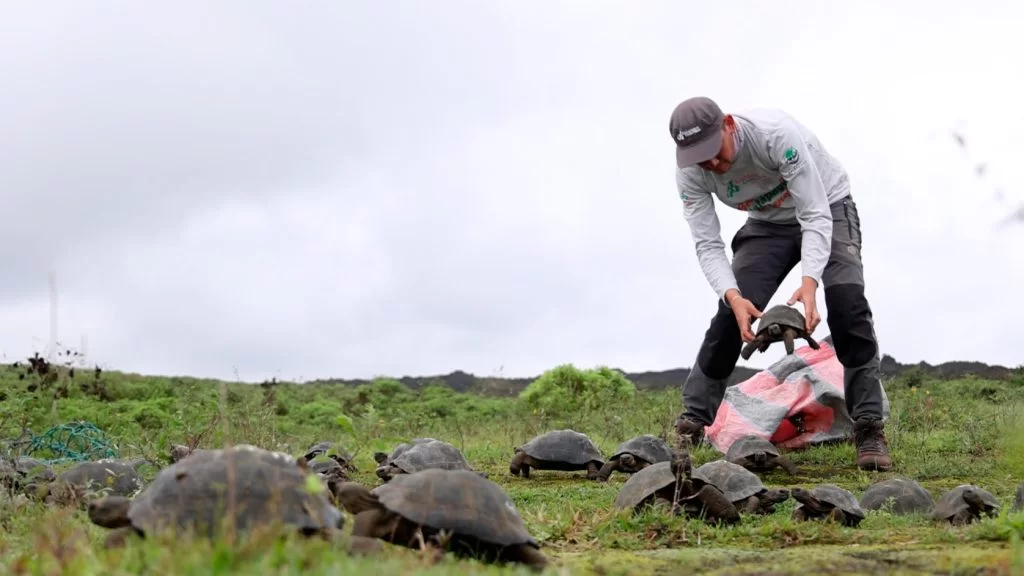
©Galápagos Conservancy
Galapagos also hosts over 30,000 residents who work, study, and live in this natural paradise. The island communities are crucial in determining the future of these lands. Most Galapagos residents are dependent on terrestrial and marine resources to survive.
Environmental education is the common thread that unites the community in its efforts to protect and conserve.
Galapagos Conservancy is deeply committed to the cause and spearheads an education program on sustainability that will change perspectives and actions for present and future generations. Over 7,000 students can learn from 450 educators who are trained in sustainability pedagogy about their role in protecting these islands. Environmental education is not limited to the classroom. It permeates every home, street and pathway. Conservation becomes a part of the fabric of daily life.
Galapagos Conservancy has a significant impact on the world beyond classrooms through its grants for conservation. It supports local projects and initiatives that aim to pioneer the protection of this unique eco-system. This community collaboration, which includes 135 projects on the islands, serves as a link between the locals and their natural heritage. It also highlights the diversity and commitment of the efforts to protect Galapagos.
We are extending an invitation to action today. Your support and participation in this collective effort for a sustainable tomorrow is needed by the Galapagos Archipelago. Your contribution strengthens the bonds between the community and conservation. Each sustainable practice that you implement in your community makes the future of our planet brighter. You can help protect biodiversity and beauty by joining Galapagos Conservancy. Your participation in this journey towards a future in which the Galapagos Archipelago is in its full splendor, is crucial.
We can continue to amaze and inspire future generations with the help of the unwavering community commitment and your invaluable support.
The entire archipelago suffers as the temperature and nutrients levels in the waters of Galapagos fluctuate. El Niño’s warm spell is bad for marine life that thrives under the cooler conditions of the Humboldt. Sea lions and boobies are among the animals that struggle to find food. They often give up breeding and extend their range to search for food.
The warm seas evaporate more water, increasing the amount of rain on the usually dry and hot archipelago. The influx of rainfall in Galapagos has profound effects on the land. Rain triggers a far greater productivity of land and alleviates the usual drought conditions in Galapagos. The rain triggers a surge in plant growth, insect proliferation, and many wildlife types double or triple their reproduction.
El Niño, a natural phenomenon that occurs every 2-7 year, has increased in intensity since the end of the 20th century. This may be due to greenhouse gas emissions caused by humans, but this direct cause is not yet confirmed. We can only watch as it unfolds, but we know that Galapagos is going to face many challenges. Galapagos faces many challenges, including heavy rainfall, warm unproductive waters, and sea-level rises such as the 45 centimeters in 1997-1998.
We support many efforts in the archipelago, helping both wildlife and humans adapt to El Niño. This includes assisting municipalities with impending infrastructure threats, anticipating increased invasive species controls on land, as well as preparing for the recovery of coral reefs. We can only continue this vital work with your support.
Please accept my sincere thanks